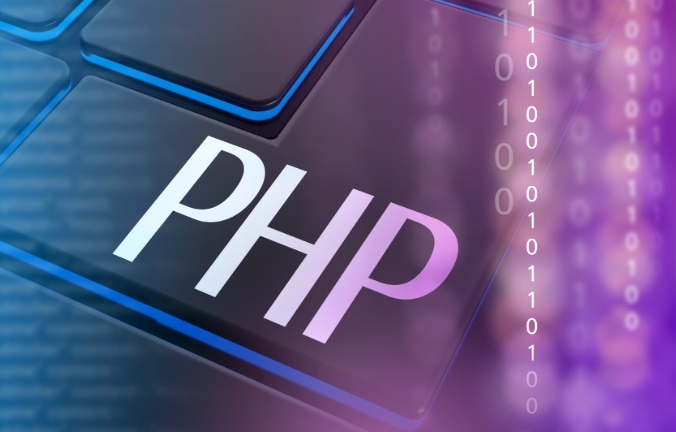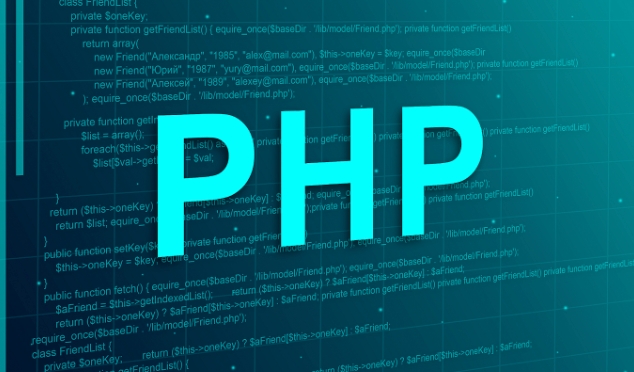There are three ways to run PHP files on Windows. First, download the Windows version of PHP and configure environment variables: download the non-thread-safe version from php.net, decompress it to a fixed path (such as C:\php), add it to the system PATH, enter php -v on the command line to display the version number, and then install it successfully. Then use php test.php to run the file. Second, use an integrated development environment such as XAMPP or WAMP: Download XAMPP and select the Apache PHP component installation, start Apache and put the PHP file into the http://localhost/yourfile.php through the browser to run. Third, run PHP in VS Code: Install the PHP Debug plug-in to ensure that PHP is installed correctly and available on the command line, create .vscode/launch.json to configure debugging parameters, press F5 to start debugging and set breakpoints. In addition, you need to pay attention to the PHP file ending with .php, the output is echo, and the path contains Chinese or spaces.

Running PHP files is actually not difficult on Windows, as long as you prepare the environment. PHP itself is a server-side language and cannot be opened directly in a browser like HTML. It requires a local server environment to parse and execute.

Install the PHP interpreter
The most basic way is to directly download the Windows version of PHP and configure the environment variables.

- Go to php.net to download the non-thread safe (NTS) or thread safe (TS) version under "Windows binaries" (NTS is usually recommended)
- Unzip to a fixed path, such as
C:\php - Add this directory to the system PATH environment variable
- Open the command line and enter
php -v, see the version number and the installation is successful
At this time, you can run the .php file on the command line, such as entering php test.php , provided that the file exists in the current directory.
Using an Integrated Development Environment (XAMPP/WAMP)
If you don't want to configure step by step, an easier way is to use integrated environment tools such as XAMPP or WAMP.

These tools come with Apache, MySQL and PHP, and can be run after one-click installation:
- Download XAMPP
- Select the components you need during installation (usually, Apache PHP is enough)
- Start Apache after installation is complete
- Put your PHP file in
htdocsdirectory - Visit
http://localhost/yourfile.phpby browser
This method is more suitable for beginners or when doing project development, saving the hassle of manually configuring various dependencies.
Run PHP in VS Code
If you use Visual Studio Code to write code, you can also run and debug PHP files directly inside.
- Install the PHP Debug plugin
- Make sure that PHP is installed and can be called via the command line
- Create a
.vscode/launch.jsonfile in the project root directory and configure debugging parameters - Press F5 to start debugging, set breakpoints to view variable values
In this way, you can write and test while writing code, which will be much more efficient.
Don't ignore small details
- PHP files must end in
.php, otherwise they will not be parsed - Remember to use
echoinstead of JavaScript'sconsole.log - If an error "not internal or external command" occurs, it means that the environment variable is not properly matched
- Try not to bring Chinese or spaces to avoid strange problems
Basically that's it. As long as you set up the basic environment, it is actually very fast to run a PHP file.
The above is the detailed content of How to run PHP files on Windows?. For more information, please follow other related articles on the PHP Chinese website!

Hot AI Tools

Undress AI Tool
Undress images for free

Undresser.AI Undress
AI-powered app for creating realistic nude photos

AI Clothes Remover
Online AI tool for removing clothes from photos.

Clothoff.io
AI clothes remover

Video Face Swap
Swap faces in any video effortlessly with our completely free AI face swap tool!

Hot Article

Hot Tools

Notepad++7.3.1
Easy-to-use and free code editor

SublimeText3 Chinese version
Chinese version, very easy to use

Zend Studio 13.0.1
Powerful PHP integrated development environment

Dreamweaver CS6
Visual web development tools

SublimeText3 Mac version
God-level code editing software (SublimeText3)

Hot Topics
 What are some best practices for versioning a PHP-based API?
Jun 14, 2025 am 12:27 AM
What are some best practices for versioning a PHP-based API?
Jun 14, 2025 am 12:27 AM
ToversionaPHP-basedAPIeffectively,useURL-basedversioningforclarityandeaseofrouting,separateversionedcodetoavoidconflicts,deprecateoldversionswithclearcommunication,andconsidercustomheadersonlywhennecessary.StartbyplacingtheversionintheURL(e.g.,/api/v
 How do I implement authentication and authorization in PHP?
Jun 20, 2025 am 01:03 AM
How do I implement authentication and authorization in PHP?
Jun 20, 2025 am 01:03 AM
TosecurelyhandleauthenticationandauthorizationinPHP,followthesesteps:1.Alwayshashpasswordswithpassword_hash()andverifyusingpassword_verify(),usepreparedstatementstopreventSQLinjection,andstoreuserdatain$_SESSIONafterlogin.2.Implementrole-basedaccessc
 What are the differences between procedural and object-oriented programming paradigms in PHP?
Jun 14, 2025 am 12:25 AM
What are the differences between procedural and object-oriented programming paradigms in PHP?
Jun 14, 2025 am 12:25 AM
Proceduralandobject-orientedprogramming(OOP)inPHPdiffersignificantlyinstructure,reusability,anddatahandling.1.Proceduralprogrammingusesfunctionsorganizedsequentially,suitableforsmallscripts.2.OOPorganizescodeintoclassesandobjects,modelingreal-worlden
 What are weak references (WeakMap) in PHP, and when might they be useful?
Jun 14, 2025 am 12:25 AM
What are weak references (WeakMap) in PHP, and when might they be useful?
Jun 14, 2025 am 12:25 AM
PHPdoesnothaveabuilt-inWeakMapbutoffersWeakReferenceforsimilarfunctionality.1.WeakReferenceallowsholdingreferenceswithoutpreventinggarbagecollection.2.Itisusefulforcaching,eventlisteners,andmetadatawithoutaffectingobjectlifecycles.3.YoucansimulateaWe
 How can you handle file uploads securely in PHP?
Jun 19, 2025 am 01:05 AM
How can you handle file uploads securely in PHP?
Jun 19, 2025 am 01:05 AM
To safely handle file uploads in PHP, the core is to verify file types, rename files, and restrict permissions. 1. Use finfo_file() to check the real MIME type, and only specific types such as image/jpeg are allowed; 2. Use uniqid() to generate random file names and store them in non-Web root directory; 3. Limit file size through php.ini and HTML forms, and set directory permissions to 0755; 4. Use ClamAV to scan malware to enhance security. These steps effectively prevent security vulnerabilities and ensure that the file upload process is safe and reliable.
 What are the differences between == (loose comparison) and === (strict comparison) in PHP?
Jun 19, 2025 am 01:07 AM
What are the differences between == (loose comparison) and === (strict comparison) in PHP?
Jun 19, 2025 am 01:07 AM
In PHP, the main difference between == and == is the strictness of type checking. ==Type conversion will be performed before comparison, for example, 5=="5" returns true, and ===Request that the value and type are the same before true will be returned, for example, 5==="5" returns false. In usage scenarios, === is more secure and should be used first, and == is only used when type conversion is required.
 How can you interact with NoSQL databases (e.g., MongoDB, Redis) from PHP?
Jun 19, 2025 am 01:07 AM
How can you interact with NoSQL databases (e.g., MongoDB, Redis) from PHP?
Jun 19, 2025 am 01:07 AM
Yes, PHP can interact with NoSQL databases like MongoDB and Redis through specific extensions or libraries. First, use the MongoDBPHP driver (installed through PECL or Composer) to create client instances and operate databases and collections, supporting insertion, query, aggregation and other operations; second, use the Predis library or phpredis extension to connect to Redis, perform key-value settings and acquisitions, and recommend phpredis for high-performance scenarios, while Predis is convenient for rapid deployment; both are suitable for production environments and are well-documented.
 How do I perform arithmetic operations in PHP ( , -, *, /, %)?
Jun 19, 2025 pm 05:13 PM
How do I perform arithmetic operations in PHP ( , -, *, /, %)?
Jun 19, 2025 pm 05:13 PM
The methods of using basic mathematical operations in PHP are as follows: 1. Addition signs support integers and floating-point numbers, and can also be used for variables. String numbers will be automatically converted but not recommended to dependencies; 2. Subtraction signs use - signs, variables are the same, and type conversion is also applicable; 3. Multiplication signs use * signs, which are suitable for numbers and similar strings; 4. Division uses / signs, which need to avoid dividing by zero, and note that the result may be floating-point numbers; 5. Taking the modulus signs can be used to judge odd and even numbers, and when processing negative numbers, the remainder signs are consistent with the dividend. The key to using these operators correctly is to ensure that the data types are clear and the boundary situation is handled well.






